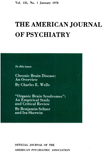FOLLOW-UP STUDY OF FORMERLY HOSPITALIZED VOLUNTARY PSYCHIATRIC PATIENTS: THE FIRST TWO YEARS
Abstract
Of 173 voluntary patients followed after discharge, data were obtained regarding outcome patterns during the first two years on 156. Nine postdischarge patterns were isolated. Over-all, 29 percent had outcomes considered good, 29 percent were equivocal and 41 percent poor. Concentrating on the differences within large diagnostic categories, this study demonstrates the increased predictive value of amplifying diagnoses by statements concerning age of onset and course of illness in schizophrenia. Schizophrenic patients with definite childhood asociality had the poorest outcome while those with cyclic or affective features and adult onset did best.
Among the nonschizophrenics the periodic depressives did best, while hysterical and passive-aggressive character disorders approximated the outcomes of the schizophrenics.
Longitudinal rather than cross-sectional follow-ups provide more useful information regarding evaluation of both treatment effects and the ideal treatment model. Refined outcome measures improve the usefulness of outcome categories.
Preliminary findings of third and fourth year experience postdischarge indicate the cyclic nature of certain illnesses, with some having short periods and others having long periods.
Access content
To read the fulltext, please use one of the options below to sign in or purchase access.- Personal login
- Institutional Login
- Sign in via OpenAthens
- Register for access
-
Please login/register if you wish to pair your device and check access availability.
Not a subscriber?
PsychiatryOnline subscription options offer access to the DSM-5 library, books, journals, CME, and patient resources. This all-in-one virtual library provides psychiatrists and mental health professionals with key resources for diagnosis, treatment, research, and professional development.
Need more help? PsychiatryOnline Customer Service may be reached by emailing [email protected] or by calling 800-368-5777 (in the U.S.) or 703-907-7322 (outside the U.S.).



